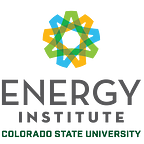Spotlight on Kirk Evans
Kirk Evans grew up on a small grain farm near the tiny town of Two Buttes, Colo. (located in the far Southeastern corner of the state). His dad and grandfather were natural mechanics, always fixing and upgrading their farm equipment by hand. From them Evans learned to do the same and went on to become a professional mechanic for John Deere.
But by the late 90’s, Evans had decided that he wanted to be an engineer and had enrolled as a non-traditional student at Colorado State University (CSU). His unique background and expertise made him a perfect fit for CSU’s Energy and Engines Conversion Laboratory (EECL).
Evan’s recalls learning about the EECL from a professor and deciding to send in his resume. But then nothing happened, so he went in person and asked Executive Director of the Energy Institute Bryan Willson to hire him. Reluctantly, as Evans remembers it, he was hired on as a student worker to run tests on engines.
Back then the EECL was made up of a small, tight-knit group. “In a lot of ways, it was almost like a family. We all had the same goal of success for our projects and we were willing to wear whatever hat fit that day,” he said.
Almost right away Evan’s found himself filling in where needed. His first project, was working remotely with a doctorate student on a small natural gas engine. Since the student was remote, Evan’s suddenly found himself making decisions and in a leadership role.
Soon after, Evans was asked by Associate Professor Dan Olsen to run a new project referred to as “the mixing project.” This project aimed to study how air and fuel mixed in an engine chamber using planar laser induced florescence to see this process taking place.
But before the project could even begin, Evans was tasked with clearing space in the crowded basement of the old Powerhouse, which at that time was full of junk collected over the years and miscellaneous concrete structures from its previous life as a power plant. And as luck would have it, the space in the basement wasn’t tall enough, so Evans had to dig a sub-floor for the project. Finally, Evans retrofitted a cylinder of the GMV engine so that researchers would be able to see into it for their tests, and designed a special hydraulics system to mimic the GMV engine. Once all that troubleshooting was done, the project studying mixing began.
This “can-do” attitude combined with Evans skill set has taken him from a Student intern to now the Director of Engineering at CSU’s Energy Institute. “He really has been a huge part of building the engines program into what it is today. Much of our work is sponsored by companies, who expect us to work on fast-paced industrial timelines. Kirk helps negotiate research objectives with sponsors, then translates that into development and test programs, and then works with our staff and students to implement on-time and on-budget. Along the way, he somehow finds the time to be an effective teacher and mentor to the students and staff on his team. Kirk has been a crucial part of the success of the EECL and Powerhouse,” said Willson.
Others, such as Joseph Schmidt also remember Evans positive attitude:
“It must have been in the spring of 2000. Suzanne and I just bought used 78’ Ford F-250 pickup as we had a new house that we wanted to do work on. The truck needed some work, maybe ball joints and or brakes. Kirk offered to do the work for a really good price and I knew he could do it ten times faster so I took him up on it. He got the truck done and we cashed out leaving me a little dumbfounded how easy, quick, and painless it was to have a pro to do the job as Kirk had many years in already as ag equipment mechanic in eastern Colorado. The conversation turned to the 82’ Chevy Blazer I was selling because I couldn’t afford to keep both. The Blazer had nice factory aluminum wheels that Kirk liked as he had a blue Chevy S-10 pickup he was fond of even though it had the drab stock steel wheels with new tires, and he asked me if I would swap wheels with him. I could see where the wheels would look nice on his truck and he saved me a lot of headache on mine, so I said have at it. I left my Blazer with him and took the Ford home thinking he would just run vehicles down to the tire shop swap out the tires and pay the mounting fees. When I got back to the lab a short while later both vehicles his pick-up and my Blazer were still where I left them but he was airing up the last two tires and putting them on the Blazer. I was trying to figure out what he was doing when I saw his tires irons on the ground and come to realize he had dismounted remounted all eight tires by hand, that’s thirty-two tire beads around and around. He had a big grin on his face as if he just found a winning lottery ticket, and I was again dumbfounded anybody was willing to do that much work for a set of wheels. But as he puts it,’ there isn’t any tire machine for tractor wheels, so these were easy.’” — Memory of Evans as told by Schmidt.
Today, Evans is situated in the heart of the Powerhouse. He often works out of the Engine Control Room, surrounded by co-workers and on some days fast food. “I know it’s a cliché, but if you do something you love, you will never work a day in your life. It really has been fun working here in the lab and following along with Bryan’s vision. It has kept the work interesting.”
